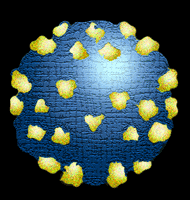AIDS HIV - General Information
Created | Updated Jun 30, 2009
Visible Features | Global Epidemiologic Statistics | Controversy

The acquired immunodeficiency syndrome (AIDS) is the last stage of a complicated disease associated with an infection by the human immunodeficiency virus (HIV). At the time of writing there are no cures or vaccines for this deadly disease. HIV is transmitted exclusively through cell fluids, that is, blood, semen and breast milk. It is not transmissible by skin contact or saliva. Currently the only approach to confront this disease is to prevent it from spreading. To accomplish this, precautionary measures must be taken. On an individual level precautionary measures include the practice of so-called 'safe sex' (ie, the use of condoms along with a careful choice of sexual partners) and the use of sterile injection needles. On a more general level, precautionary measures taken by governments include a thorough control of the blood banks, making accurate information broadly available as well as adequate funding of research.
Epidemiologic Statistics
Even with the aid of mass communication, the number of infected people is still growing regardless of the socio-economic status of the countries. Between 1997 and 2001 the global growth stopped rising exponentially, and levelled off to a more or less linear infection rate of 5.3 million new cases per year. The number of infected people rose from roughly 10 million in 1990 to 30 million in 1997, by the end of 2001 there were 40 million people infected. Between 1997 and 2001 27.4 million people got infected, and 17.4 million people died1.
The Disease, Transmission, Treatment and Tests
The following criteria define the acquired immunodeficiency syndrome - AIDS:
A T-helper lymphocyte cell count below 200 cells per microlitre of blood
The presence of opportunistic infections (OI)
The presence of certain rare forms of cancer, namely Kaposi's sarcoma (KS) and non-Hodgkin's-Lymphoma (NHL)
- The lack of any other explanation for a deficient immune-system (eg, hereditary immunodeficiency, or a preceding chemotherapy)
OIs can be due to any infecting organism (eg, virus, fungus, bacteria, other parasites) in a generalised form (ie, spread throughout the body), which would never occur in patients with a healthy immune-system. An example of this would be the presence of herpes simplex virus (HSV) in the brain or in the liver, as HSV is never found in these organs in healthy patients.
AIDS is caused by the human immunodeficiency virus (HIV), a very special form of virus, namely a retro-virus2. HIV is transmitted by cell fluids in semen, blood and breast-milk exclusively. It is worth reiterating that HIV is not transmitted through skin contact, saliva or sweat. Before developing AIDS there are other stages with less characteristic symptoms. The incubation/latency time until the development of AIDS is in the order of 5-10 years.
The HIV mainly attacks certain white blood cells, also called T4-helper lymphocytes. These cells are responsible for targeting infected or misbehaving cells and recruiting T-killer cells to eliminate these cells. With the T4-helper cells knocked out, the body is not able to spot infections and thus keep them at bay (that's why OIs occur). These infecting organisms can additionally trigger cancer and are very hard to treat. The organism is also not able to control cells which develop cancer spontaneously. Ultimately AIDS patients die because the body loses the ability to control itself on a cellular level.
Treatment strategies have been developed that can significantly prolong the life expectancy of an HIV positive individual before he/she develops AIDS. However, the medications are expensive and may cause serious collateral damage. There are no vaccines at present, and no fast tests to detect the virus. The most common tests detect specific antibodies in the person's blood. Antibodies are not present immediately after infection. It takes 3 weeks to 3 months for them to develop. For that reason it is recommended for anyone who suspects HIV contamination to take more than one test to confirm his/her status allowing some months time between the tests.
Controversy
In the late 1980s some serious questions relating to the disease and the virus were being raised. Some scientists even went further and questioned the whole AIDS-HIV connection. They proposed that HIV was just another opportunistic infection connected to AIDS, but that AIDS itself was a result of specific lifestyle choices. These propositions were proven wrong soon after they were made public. Today there is a rather complete understanding of how HIV causes AIDS. Nevertheless, the controversy about the link between HIV and AIDS still resurfaces periodically, resulting in media attention and generating renewed public interest in the controversial perspective. Many people subscribe to myths or conspiracy theories about the disease for many reasons.

